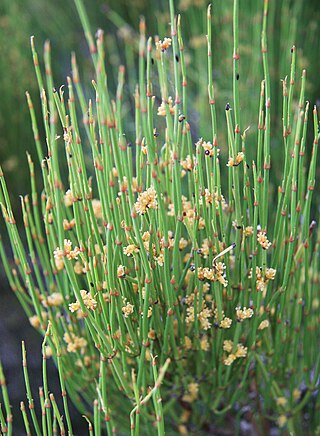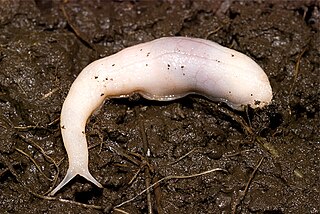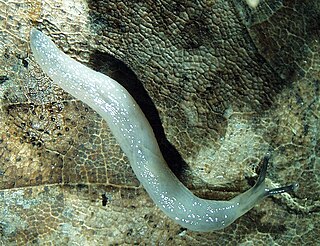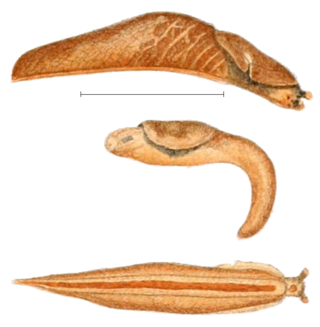Related Research Articles

Teratoscincus is a genus of geckos commonly referred to as wonder geckos or frog-eyed geckos; it is the only genus within the subfamily Teratoscincinae of the family Sphaerodactylidae. Species in the genus Teratoscincus are found from the Arabian Peninsula in Qatar, the United Arab Emirates, and Oman, west across southern Asia in Iran, Afghanistan, and Pakistan, north to Russia, Kazakhstan, Turkmenistan, Uzbekistan, and Tajikistan to Mongolia and China. The genus consists of nine species.

Ablepharus is a genus of skinks that contains the common snake-eyed skinks. Both their scientific and common names refer to the fact that their eyelids have fused to a translucent capsule; as in snakes, they thus are physically incapable of blinking. They are small lizards and prefer to live in the leaf litter of dry fields and hills. Their scales give them a very shiny, bronze appearance with a characteristically dark stripe down the sides of their bodies. They prey on small insects and other small mollusks.

Ephedra is a genus of gymnosperm shrubs. The various species of Ephedra are widespread in many arid regions of the world, ranging across southwestern North America, southern Europe, northern Africa, southwest and central Asia, northern China and western South America. It is the only extant genus in its family, Ephedraceae, and order, Ephedrales, and one of the three living members of the division Gnetophyta alongside Gnetum and Welwitschia.

Arion is a genus of air-breathing land slugs in the family Arionidae, the roundback slugs. Most species of this Palearctic genus are native to the Iberian Peninsula.

Trigonochlamydidae is a family of air-breathing land slugs, terrestrial gastropod molluscs in the clade Eupulmonata.

Selenochlamys is a genus of predatory air-breathing land slugs, shell-less pulmonate gastropod molluscs. When described it was supposed to be in the family Trigonochlamydidae, but DNA evidence has shown it to be in the Oxychilidae instead.

Boettgerilla pallens, common name the worm slug, is a European species of air-breathing land slug, a terrestrial pulmonate gastropod mollusk in the family Boettgerillidae.

Juliidae, common name the bivalved gastropods, is a family of minute sea snails, marine gastropod mollusks or micromollusks in the superfamily Oxynooidea, an opisthobranch group.
Drilolestes retowskii is a species of predatory air-breathing land slug. It is a shell-less pulmonate gastropod mollusc in the family Trigonochlamydidae.

Parmacellilla filipowitschi is a species of predatory air-breathing land slug. It is a shell-less pulmonate gastropod mollusc in the family Trigonochlamydidae.
Trigonochlamys imitatrix is a species of predatory air-breathing land slug. It is a shell-less pulmonate gastropod mollusc in the family Trigonochlamydidae.

Boettgerilla compressa is a species of air-breathing land slug, a terrestrial pulmonate gastropod mollusk in the family Boettgerillidae.
Boreolestes is a genus of predatory air-breathing land slugs, shell-less pulmonate gastropod mollusks in the family Trigonochlamydidae.
Boreolestes likharevi is a species of predatory air-breathing land slug, a shell-less pulmonate gastropod mollusk in the family Trigonochlamydidae.
Boreolestes sylvestris is a species of predatory air-breathing land slug, a shell-less pulmonate gastropod mollusk in the family Trigonochlamydidae.
Khostalestes kochetkovi is a species of predatory air-breathing land slug. It is a shell-less pulmonate gastropod mollusc in the family Trigonochlamydidae.
Lesticulus nocturnus is a species of predatory air-breathing land slug. It is a shell-less pulmonate gastropod mollusc in the family Trigonochlamydidae.
References
- ↑ Simroth H. (1901). Die Nacktschnecken des Russischen Reiches. St.-Petersburg. 321 p.
- ↑ Martens E. v. (1880). "Aufzählung der von. Dr. Alexander Brandt in Russisch-Armenien gesammelten Mollusken". Bulletin de l’Académie Impériale des Sciences de St. Pétersbourg26: 142-158.
- 1 2 3 4 5 6 7 8 9 Kantor Yu I., Vinarski M. V., Schileyko A. A. & Sysoev A. V.(published online on December 22, 2009). "Catalogue of the continental mollusks of Russia and adjacent territories". Version 2.3. Archived 2018-12-22 at the Wayback Machine
- ↑ Suvorov A. N. (2003). "A new species and genus of carnivorous slugs (Pulmonata Trigonochlamydidae) from West Transcaucasia". Ruthenica13: 149-152. abstract Archived 2020-07-13 at the Wayback Machine .